How to water zucchini?
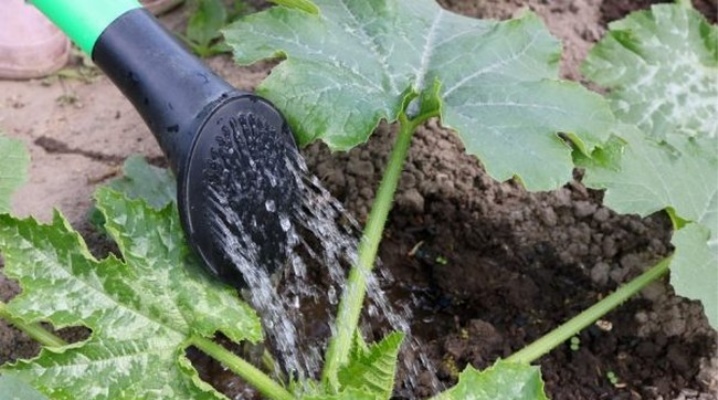
Zucchini is a garden crop that does not need special care. But regular and correct watering can increase the yield of the plant and make it healthier.
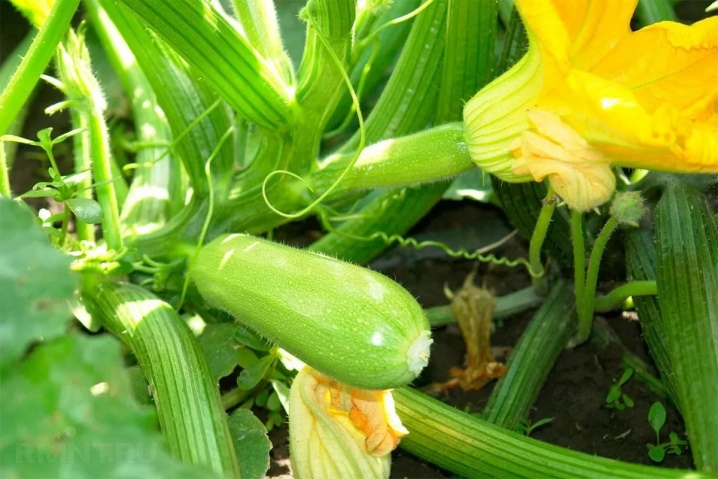
General rules
Watering zucchini is needed at all stages of their development. Moisture deficiency can lead to the following problems:
- a significant decrease in yield;
- a decrease in the size of ripe fruits;
- insufficient juiciness of zucchini;
- loss of their taste;
- reducing the number of ovaries.
To prevent this from happening, the plant must be watered regularly. The frequency of watering depends on the place where it grows and the weather conditions.... It is necessary to moisten the soil by about 40 cm. This is especially important during the period when the plant bears fruit.
In this case, it is also worth remembering that an excess of moisture can also be superfluous. If the zucchini is watered too often and abundantly, then the plants will be susceptible to various diseases. In addition, the fruit may start to rot and the crop will not be stored for a long time.
It is best to water the plants during the minimum solar activity. It is advisable to do this in the evening.
If the weather is not dry, it is allowed to water the zucchini until 9 am. But it is important that moisture does not get on the stems and leaves.
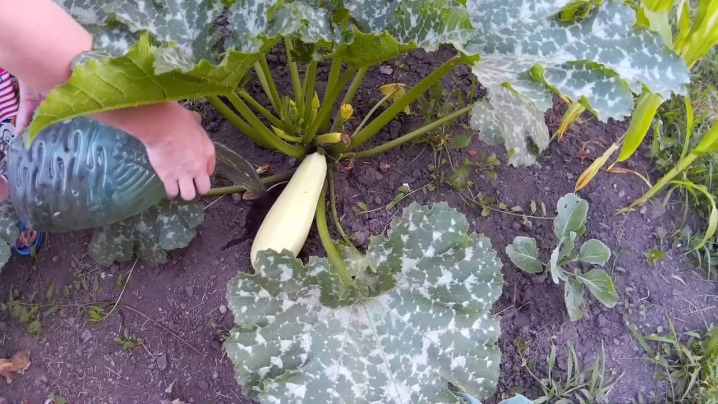
What kind of water is right?
Zucchini are very demanding on water quality. It should not be chlorinated. It is recommended to use settled liquid. After all, after the water settles, all impurities settle to the bottom. Sediment is not used for irrigation.
Many gardeners believe that the best option for irrigating the beds is rainwater collected under the drain. It can be pre-filled in large buckets or barrels.
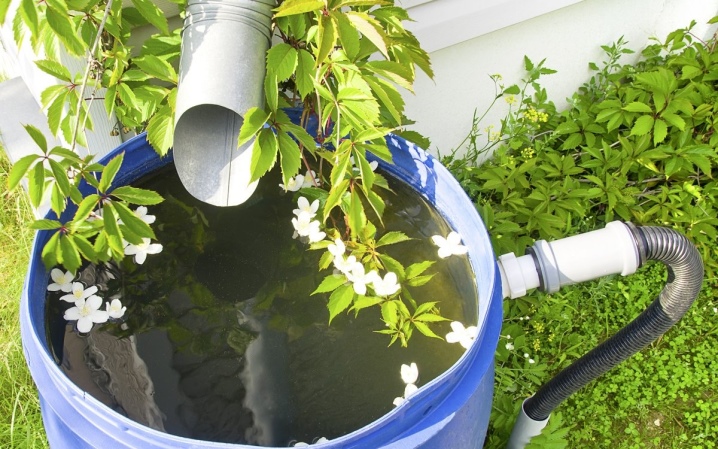
The temperature of the water also plays an important role. In no case should it be cold or hot. Cold liquid is poorly absorbed by the roots. If used to water plants on a hot day, it can shock the plant. As a result, the growth and development of culture can be greatly slowed down.
Hot water also has a negative effect on the health of plants. If you use it for watering, the risk of developing various diseases may increase. The optimum water temperature is 10-20 degrees.
Volume and frequency of watering
The volume of water used for watering plants is also important. The amount of liquid used mainly depends on the air temperature. If the weather is hot and dry, you can water the plant more abundantly. At normal air temperatures, excess moisture will negatively affect the condition of the plants.
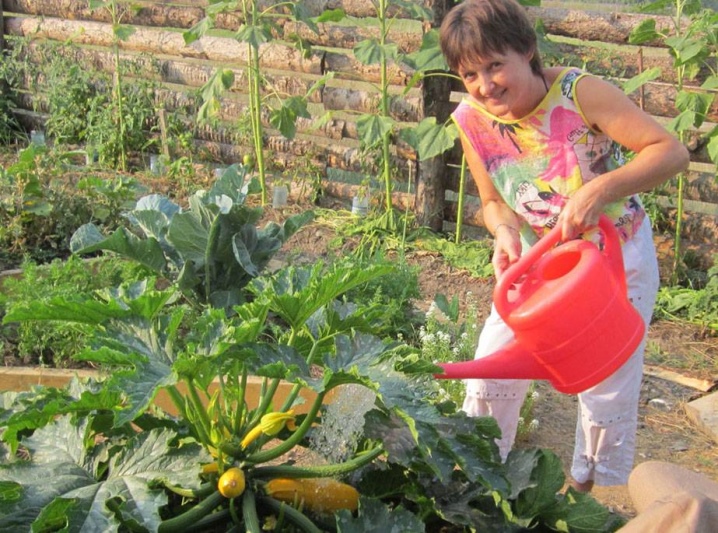
It is also important to consider at what stage of development the plant is now. At different times, zucchini need different amounts of water.
- After disembarking... At this time, the rate of water used for irrigation is 4-5 liters per 1 sq. m. Watering the plants after planting is necessary so that they immediately take root. This should be done every three days.
- During the flowering period. When a plant blooms and an ovary begins to form on it, it needs a little more water. At this stage, you need to use about 10 liters of water for irrigation. It is worth watering the plants once a week.
- During fruiting. At this stage, 15-20 liters of water is consumed per square meter. It is worth determining the period of the next watering, focusing on the state of the zucchini and the land next to them. As a rule, they are watered no more than once every 8-10 days.
Separately, it should be noted that plants need watering during fertilization.Top dressing works much better when applied to well-moistened soil.
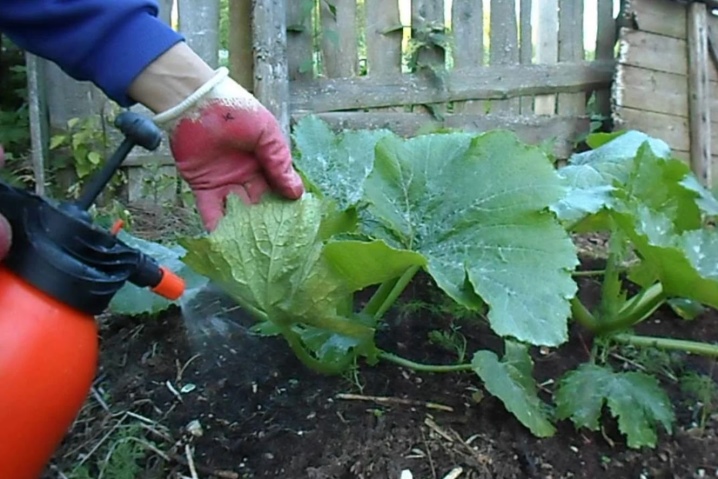
In the greenhouse
Plants that grow in the greenhouse need to be watered about once a week. It is worth navigating by looking at the condition of the soil. If it dries up and cracks, then it's time to water the bushes. To irrigate zucchini in the greenhouse, use soft water at room temperature. One bush usually takes about one bucket of liquid.
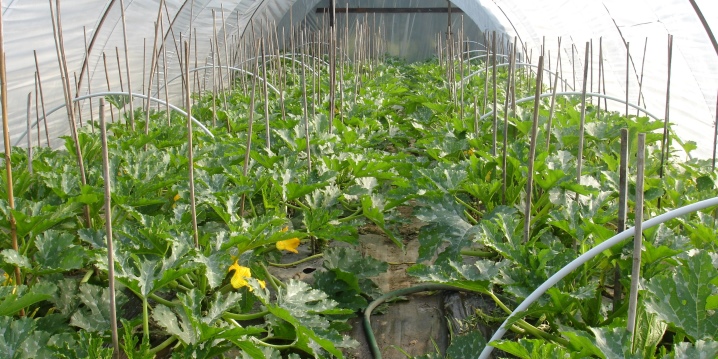
In the open field
Outdoor squash is best watered in the evening or early morning. At the same time, the weather should not be too hot. Zucchini can be watered either manually or using more complex irrigation systems. The frequency of watering is also influenced by the soil in which the zucchini grows. If the soil is sandy loam or sandy, you will have to irrigate the plants more often. If it is loamy or clayey, less often.
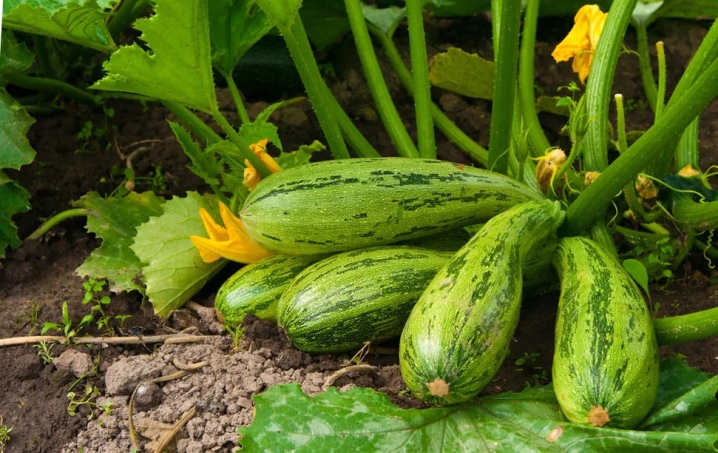
Irrigation methods
There are several main ways to water the beds, which are used by both ordinary gardeners and those who grow their crops on an industrial scale.
Manual
Zucchini growing in a small area can be watered by hand using a watering can or a hose. The stream of water in the process must be directed to the root. If the plants are watered with a hose, a special spray nozzle must be used. It is best to irrigate zucchini by hand in the evening hours.
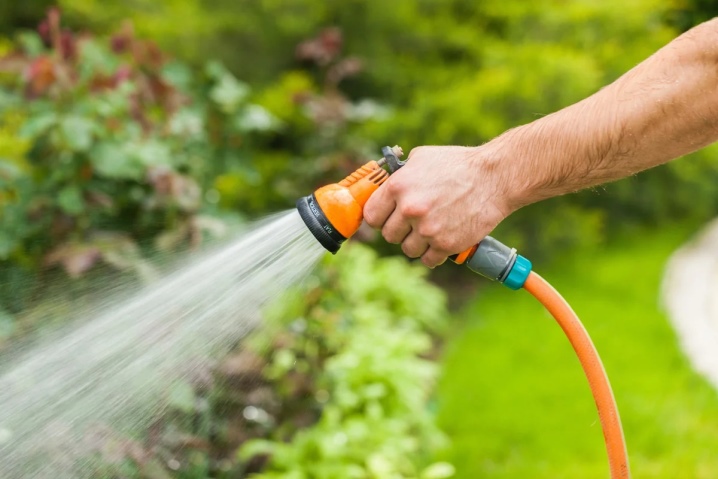
Subsoil
The hose can also be used for subsoil irrigation. Several holes should be made in the hose at the same distance. After that, it must be buried at a shallow depth opposite a row of zucchini. The hose fixed in this way is connected to the water supply system. If necessary, the water can be connected and used for regular watering of the plants.
You can also go the other way: use plastic or steel pipes instead of a hose. Small holes are also made in them, and after the pipes are buried in the aisles. They need to be located deeper than the hose. After that, such a water supply system is also connected to the water supply.
The advantage of this irrigation method is that all the water is used to moisturize the root system of the squash. At the same time, the leaves remain dry, which is especially important during the daytime.
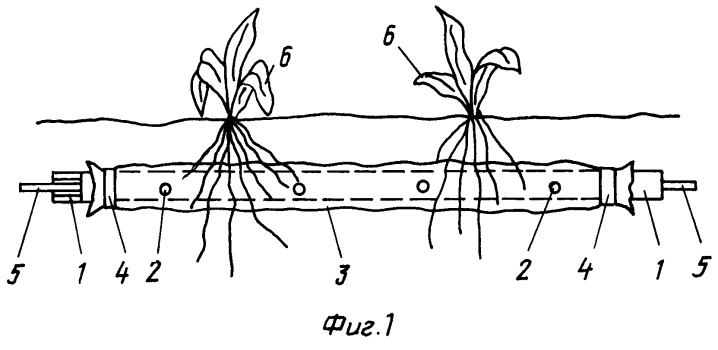
Dosed
Watering the plant can also be done using properly secured bottles. In this case, water will constantly flow to the roots. Preparing watering equipment is very simple.
- The bottom is cut out in the bottles, and several holes are made in the lids with the help of an awl.
- After that, a small hole is dug 20 centimeters from the zucchini bush. The bottle is placed in it with the neck down. It must be fixed at an angle of 45 degrees and filled with warm settled water. It will be dosed into the soil. Therefore, water will need to be added from time to time.
Some gardeners buy special nozzles with long necks.... They are wrapped around bottles and buried in the ground. If you use these nozzles, you don't have to dig holes.
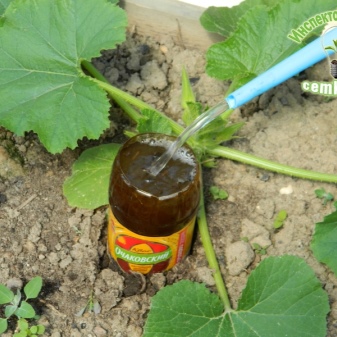
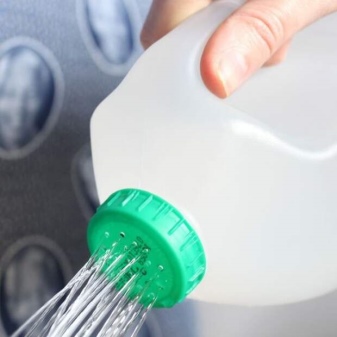
Wick
The main advantages of this irrigation method are efficiency and simplicity. Everyone can organize the system with their own hands.
- First of all, on different sides of the site, it is necessary to slightly deepen the containers with water into the ground. You can use old pots, buckets or ordinary plastic bottles.
- Next, you need to prepare the harnesses from the fabric. The material must be very dense. The length of the fabric depends on the size of the area.
- Tissue bundles must be dug along the row with zucchini. You need to bury them in the ground by 15 cm.
- The containers prepared in advance must be filled with water and one end of the tourniquet should be lowered there. It will get wet and gradually transfer moisture to the ground. This will keep the soil constantly moist. The main thing is not to forget to add water in time to containers at the edges of the beds.

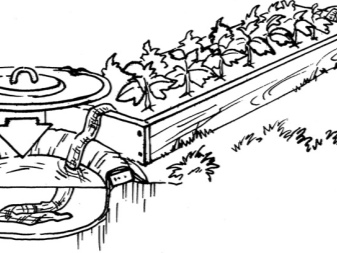
Sprinkling
This method of watering plants is usually used in large areas.In this case, special equipment is used to irrigate the beds, which is connected to the central water supply. Water is supplied under high pressure. Because of this, the plants are watered with small drops that disperse in the form of fog.
The advantage of this irrigation method is a low water consumption and uniformity of its distribution. But this method also has a significant disadvantage. To water the plants, it is necessary to install a complex and expensive system, and this is not always justified.

Drip
Drip irrigation devices are supplied with water pipes. They fall into several categories.
- Adjustable. Such structures are convenient to use on your site. They allow you to control the flow of water. In addition, the area is watered evenly.
- Compensated. They are complemented by a valve-membrane mechanism. Thanks to this, the beds are also irrigated evenly.
- Uncompensated. The design differs in that the water is supplied unevenly. They can be used only on flat surfaces, otherwise the first bushes will be heavily flooded with water, and the latter, on the contrary, will not be enough.

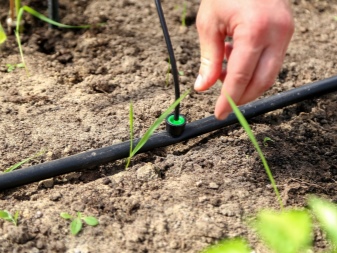
Useful Tips
The advice of experienced summer residents will also help to grow a good harvest of zucchini. If you follow them, you can avoid common mistakes.
- It is best to water the plants at the root, especially if watering is carried out during the day. If water gets on the leaves when the sun is active, it can cause burns on them. In addition, if you use sprinklers, then all the moisture will remain on the ground part of the squash, while it should flow to the roots.
- After watering the plants, the soil must be loosened regularly. If you do everything correctly, the water will not stagnate, and a "crust" will not form on the surface.
- Zucchini should be weeded regularly. The fact is that weeds take moisture and nutrients from the soil. Therefore, the plant develops worse and remains weaker.
- It is also very important to mulch the soil regularly. The ground should be covered with a layer of dried herbs or leaves. Mulch prevents the sun from drying out the soil and retains moisture under the plant. If gardeners mulch the soil, they may water the plants less frequently.
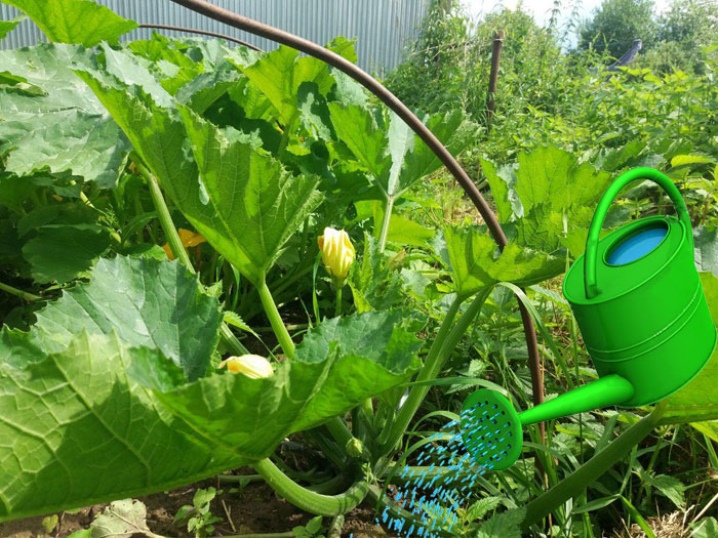
Watering zucchini is an important part of basic crop care. If you provide the plants with enough moisture, then the harvest will be good and of very high quality, regardless of where the zucchini is grown.
How to properly water zucchini is shown in the next video.













The comment was sent successfully.